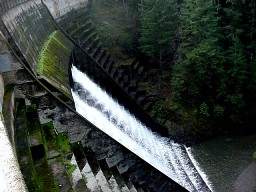
A version of this post also appears on Dan Brekke’s personal blog, Infospigot. Also see our updated map of reservoir conditions at the end of this post.
By Dan Brekke
Is California’s drought over? OK, let’s take a step back. Yes, I realize one could debate whether the last three years in California actually constitute a drought. But that’s a discussion for another time. For now, I think everyone can agree that we’ve had lower-than-average precipitation for the past three years.
The only reason to ask the question is that, after the first half of the wet season delivered only spotty rain, we’ve had a pretty solid week of downpours. Water is sluicing into our reservoirs, and the hills are greening up. Some counties, like Marin, have water tumbling down the spillways. All of that is a sign of what we think winter should be here.
My favorite water statistic from last week: when the storms were at their heaviest around Lake Shasta, California’s biggest reservoir, water was flowing into the lake at about 500,000 gallons per second. That’s 1.5 acre feet, or about enough for two-to-three “average” households for a year, every second.*
Amazing numbers like that aside, the people who get paid to think about whether the drought is over say “not yet.” Last week, Quest managing editor Paul Rogers wrote a good summary of the situation, for The San Jose Mercury News.
Rogers’ story does contain one bit of quirky California thinking about rain and water, though. He quotes a well established local meteorologist, Jan Null, about where we stand in terms of normal rainfall, saying: “This is a great start, but we need to keep it going.”
Of course, Null recognizes better than most that the amount of rain we get and when we get it is out of anyone’s control. But once you understand the importance of water in California, once you get how crucial the winter rains are, there’s a score-keeping aspect to weather-watching here. It becomes second nature to study the rain gauge and the seasonal precipitation table as an index of performance, a reflection on whether a great collective goal is being attained. Lots of rain means we’re doing well (and that we can put the complexities of water supply out of our minds). A dry spell means we’re failing (and the prospect of hell to pay, or at least the strong possibility of stringent conservation measures).
But in reality, there’s no performance going on. The rain is the rain, and the climate is the climate. California’s rainfall is famously variable. Dry spells can be counted on and the current run of dry years is the third we’ve had since I arrived in Berkeley in the 1970s.
My first California winter, 1976-’77, was bone-dry and was in fact the second year of the driest two-year period ever recorded here. A decade later, from roughly 1986 through 1992, we had another run of dry years. And if our winter rains were to stop now, we’d be in the fourth year of drier-than-normal years. In between these periods we’ve had average years and very wet years and years that didn’t quite hit the average. That might not be too different from anywhere else. The reason it’s a bigger deal here than it might be in, say, Wisconsin, is that we have a six-month dry season. We need to store water to get through that. We have 37 million people and millions and millions acres of farmland that need water, whether it’s falling from the sky or not. Thus the need to believe we can wish the rain to keep going during the wet season and the tendency to feel disappointment when the winter turns into a string of dry, sunny days.
*500,000 gallons per second. Here’s the arithmetic: California Department of Water Resources figures show that in the hour between noon and 1 p.m. on Tuesday, January 19, net inflow into the lake was 66,288 cubic feet per second. That’s the highest inflow figure for any single hour that week. One cubic foot equals 7.48 gallons. 66,288*7.48 = 495,834.24 gallons. One acre-foot = 325,851 gallons. And 495,834.24/325,851 = 1.52 acre-feet. Per second. For the entire 24 hours of the 19th, Lake Shasta’s inflow averaged just over 1 acre-foot a second.
View KQED: California Reservoir Watch in a larger map
2 thoughts on “California Storms: A Dent in the Drought”
Comments are closed.

Been a very wet winter in Fla too, we both needed it – congrats